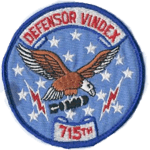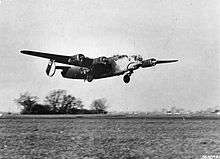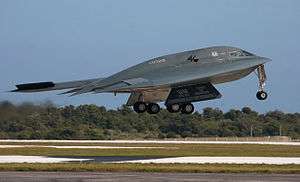715th Weapons Squadron
| 715th Weapons Squadron | |
|---|---|
|
B-2 Spirit 88-0329 taking off from Andersen AFB | |
| Active | 1943-1966; 1970-1990; 2003-2005 |
| Country |
|
| Branch |
|
| Type | Squadron |
| Role | Advanced B-2 Spirt bombardment Training |
| Part of | USAF Weapons School |
| Garrison/HQ |
Nellis AFB, Nevada GSU at Whiteman AFB, Missouri |
| Engagements |
World War II (EAME Theater) |
| Decorations |
Air Force Outstanding Unit Award (4x) |
| Insignia | |
| 715th Weapons Squadron emblem |
 |
The 715th Weapons Squadron (715 WPS) is an inactive United States Air Force unit. It was last assigned to the USAF Weapons School at Whiteman Air Force Base, Missouri. It was inactivated 9 September 2005
The 715th Bomb Squadron was first activated on 6 April 1943 and saw its first combat in the European Theater of Operations over the skies of Germany in December of that year flying the B-24 Liberator. In 1946 the 715th transitioned to the B-29 and was reassigned to the 509th Composite Group, the same organization that ended the war in the Pacific with the dropping of two atomic bombs on Japan. The 715th continued service flying the B-29, B-50, and B-47 until it was inactivated in 1966. The 715th was reactivated in 1970 at Pease AFB as the first operational FB-111 squadron.
History
World War II

Activated in mid-1943 as a B-24 Liberator heavy bomb squadron, trained under Second Air Force. Deployed to England in the European Theater of Operations (ETO) during November 1943, assigned to VIII Bomber Command as a strategic bombardment squadron. Participated in the air offensive over Nazi Germany and Occupied Europe until German capitulation in May 1945. Personnel demobilized in England and returned to the United States; squadron reassigned to Second Air Force and re-equipped with B-29 Superfortresses, being trained for deployment to Pacific Theater. Japanese capitulation canceled deployment and was assigned to Fort Worth AAF, Texas as Continental Air Forces, later Strategic Air Command squadron.
Cold War
Original host unit inactivated due to budget and personnel shortages in May 1946; squadron reassigned and consolidated into 509th Composite Group. B-29s modified into atomic capable silverplate configuration and stood nuclear alert. Began upgrading to the new B-50 Superfortress, an advanced version of the B-29 in 1949. The B-50 gave the unit the capability to carry heavy loads of conventional weapons faster and farther as well as being designed for atomic bomb missions if necessary. Squadron deployed to SAC airfields in England, and also to Andersen AFB, Guam on long-term deployments in the 1950s.
By 1951, the emergence of the Soviet Mig-15 interceptor in the skies of North Korea signaled the end of the propeller-driven B-50 as a first-line strategic bomber. The squadron moved into the jet age when it received new, swept wing B-47 Stratojets in 1955 which were designed to carry nuclear weapons and to penetrate Soviet air defenses with its high operational ceiling and near supersonic speed. The squadron flew the B-47 for about a decade when by the mid-1960s it had become obsolescent and vulnerable to new Soviet air defenses. The squadron began to send its stratojets to AMARC at Davis-Monthan AFB for retirement in 1965, and the unit inactivated in 1966.
Reactivated as General Dynamics FB-111A strategic bomber squadron in 1970 when aircraft became part of SAC's nuclear deterrent force. Inactivated in 1990 with retirement of weapons system.
Modern era
The Air Force Chief of Staff directed the creation of the B-2 Division, USAF Weapons School in May 2002. On 13 August 2003, the B-2 Division was re-designated as the 715th Weapons Squadron, and became an instructional squadron as part of USAF Weapons School, 2003. The 715th WPS was a Geographically Separated Unit (GSU) of the 57th Wing, assigned to Nellis AFB, Nevada. It was inactivated, and its assets re-designated as the 325th Weapons Squadron on 9 September 2005 due to budget cutbacks, being re-designated as part of the USAF Heritage program of preserving notable senior units.
Lineage

- Constituted 715th Bombardment Squadron, Heavy on 6 April 1943
- Activated on 1 May 1943
- Re-designated: 715th Bombardment Squadron, Very Heavy on 5 August 1945
- Re-designated: 715th Bombardment Squadron, Medium on 2 July 1948
- Discontinued, and inactivated, on 25 June 1966
- Activated on 1 January 1970
- Inactivated on 30 September 1990
- Re-designated 715th Weapons Squadron on 11 August 2003
- Activated and organized on August 13, 2003, assuming resources of B-2 Division, USAF Weapons School
- Inactivated and replaced by the 325th Weapons Squadron, 9 September 2005
Assignments
- 448th Bombardment Group, 1 May 1943
- 509th Composite (later, 509 Bombardment) Group, 6 May 1946
- Attached to 509th Bombardment Wing, 17 November 1947-14 September 1948 and 1 February 1951-15 June 1952
- 509th Bombardment Wing, 16 June 1952-25 June 1966; 1 January 1970-30 September 1990
- USAF Weapons School, 13 August 2003-9 September 2005
Stations
|
|
Aircraft
- B-24 Liberator, 1943–1945
- B-29 Superfortress, 1945–1951
- B-50 Superfortress, 1950–1955
- B-47 Stratojet, 1955–1965
- FB-111A, 1971-1990
- B-2 Spirit, 2003-2005
References
![]() This article incorporates public domain material from the Air Force Historical Research Agency website http://www.afhra.af.mil/.
This article incorporates public domain material from the Air Force Historical Research Agency website http://www.afhra.af.mil/.
- Maurer, Maurer, ed. (1982) [1969]. Combat Squadrons of the Air Force, World War II (PDF) (reprint ed.). Washington, DC: Office of Air Force History. ISBN 0-405-12194-6. LCCN 70605402. OCLC 72556.



